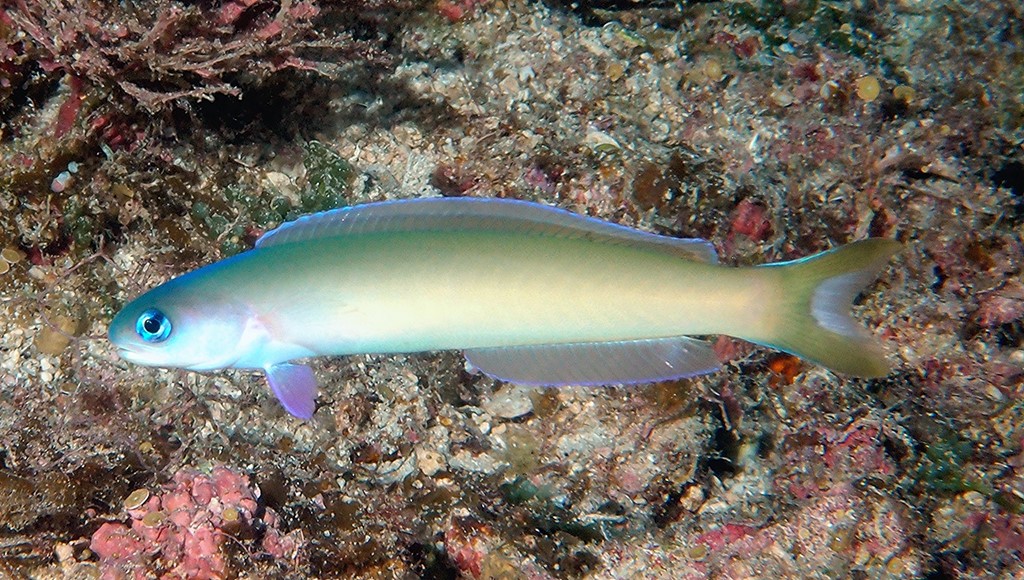HOPLOLATILUS CUNICULUS - (RANDALL & DOOLEY, 1974)
Actinopterygii (Gigaclass) > Actinopteri (Class) > Teleostei (Subclass) > Acanthuriformes (Order) > Malacanthidae (Family) > Hoplolatilus (Genus)
Etymology
Hoplolatilus: from ancient Greek, hóplon = shield. Hoplites were citizen-soldiers of Ancient Greek city-states who were primarily armed with spears and shields. Hoplite soldiers utilized the phalanx formation to be effective in war with fewer soldiers + from Latin, latus = wide, broad.
cuniculus: from Latin, cunīculus = rabbit, rabbit burrow, mine, subterranean tunnel or gallery. Referring to how it rapidly retreated into a burrow, head first, at the approach of a diver.
Biology
Inhabits muddy to rubble or rubble-sand areas of outer reef slopes. Observed a meter above the substrate and retreats to a burrow when threatened. Stomach contents consist of calanoid copepods (58 % by volume), larvaceans (20 %), siphonophores (20 %), and fish eggs (2 %). Sometimes in loose groups.
Poisson couvreur pâle, Dusky tilefish, Green tilefish, Grey tilefish, Pale sand tilefish, Grå teglfisk, Okinawa-sango-amadai, オキナワサンゴアマダイ, 似弱棘魚,
Description
Dorsal spines (total): 3-5; Dorsal soft rays (total): 29-34; Anal spines: 1-2; Anal soft rays: 19-20; Vertebrae: 24. Preopercular fine serrae: 30-58, and spine at angle smaller than pupil diameter. Pectoral fin rays: 17-18 (ususally: 17); Lateral line scales (pored): 113-140. Gill rakers: 21-23 on first arch. Cheek scales: 9-12; Opercle scales: 8-11. Vertebrae: 10 + 14. Body long and slender; Greatest depth of body: 5.1-6.3 in SL; Caudal fin slightly forked; Max. length: 16.0 cm TL. Depth range: 25 - 115 m.
Description
Dorsal spines (total): 3-5; Dorsal soft rays (total): 29-34; Anal spines: 1-2; Anal soft rays: 19-20; Vertebrae: 24. Preopercular fine serrae: 30-58, and spine at angle smaller than pupil diameter. Pectoral fin rays: 17-18 (ususally: 17); Lateral line scales (pored): 113-140. Gill rakers: 21-23 on first arch. Cheek scales: 9-12; Opercle scales: 8-11. Vertebrae: 10 + 14. Body long and slender; Greatest depth of body: 5.1-6.3 in SL; Caudal fin slightly forked; Max. length: 16.0 cm TL. Depth range: 25 - 115 m.
Color
Body pale olive-brown on dorsum, fading to pale yellow ventrally; Blue area on dorsal and rear orbital areas of head (fades quickly upon death); Dorsal fin base colored like upper body, remainder of fin bluish; Peduncle and caudal fin upper and lower lobes bright yellow (some regional slight color variations); Interior of clavicle (under opercle) without white palp of skin near pectoral-fin base.
Etymology
Hoplolatilus: from ancient Greek, hóplon = shield. Hoplites were citizen-soldiers of Ancient Greek city-states who were primarily armed with spears and shields. Hoplite soldiers utilized the phalanx formation to be effective in war with fewer soldiers + from Latin, latus = wide, broad.
cuniculus: from Latin, cunīculus = rabbit, rabbit burrow, mine, subterranean tunnel or gallery. Referring to how it rapidly retreated into a burrow, head first, at the approach of a diver.
Original description: Hoplolatilus cuniculus Randall & Dooley, 1974 - Type locality: edge of pass, Papara, off Popote Bay, Tahiti, Society Islands (French Polynesia, South Pacific), depth: 36-45 meters.
Distribution
Indo-West Pacific: KwaZulu-Natal (South Africa), East Africa, Madagascar and western Mascarenes (La Réunion, Mauritius) east to Marshall Islands and Society Islands (French Polynesia), north to Ryukyu Islands (Japan), south to Queensland (Australia), New Caledonia and Tonga.
Distribution
Indo-West Pacific: KwaZulu-Natal (South Africa), East Africa, Madagascar and western Mascarenes (La Réunion, Mauritius) east to Marshall Islands and Society Islands (French Polynesia), north to Ryukyu Islands (Japan), south to Queensland (Australia), New Caledonia and Tonga.
Biology
Inhabits muddy to rubble or rubble-sand areas of outer reef slopes. Observed a meter above the substrate and retreats to a burrow when threatened. Stomach contents consist of calanoid copepods (58 % by volume), larvaceans (20 %), siphonophores (20 %), and fish eggs (2 %). Sometimes in loose groups.
Last udpate: 2, April 2023
